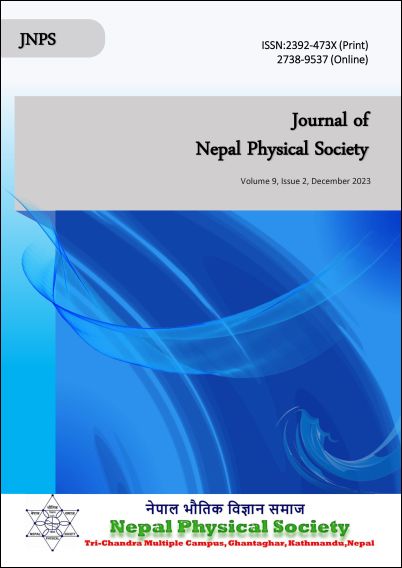Simulating and Analyzing the Electronic Structure of a Spherical Amorphous SiO2 Nanoparticle of Finite Radius
DOI:
https://doi.org/10.3126/jnphyssoc.v9i2.62285Keywords:
Amorphous silica nanoparticles,, Continuous random network, Orthogonalized, Linear Combination of Atomic Orbital, angling bonds,, Band gap.Abstract
This study focuses on the electronic structure and properties of amorphous SiO2 nanoparticle with a radius of 18 Å using Density Functional Theory and the Orthogonalized Linear Combination of Atomic Orbital method. Through employing appropriate statistical techniques, three distinct models (I, II, and III) of amorphous SiO2 nanoparticle with an 18 Å radius are generated based on the continuous random network structure incorporating periodic boundaries. The calculated Total Density of States and Partial Density of States reveal insights into the electronic interactions within the nanoparticle. The band gap values are assessed at both less accurate and more accurate potentials such that the band gap increases from 2 eV to 4.2 eV with higher potentials for Model I, where surface atoms has dangling bonds stabilized by hydrogen atoms. Model II, consisting of all surface silicon atoms bonded to four oxygen atoms, exhibits a band gap of 1 eV, increasing to 1.8 eV with higher potentials. Model III, saturated with hydrogen atoms, shows a band gap of 4 eV, decreasing to 3.75 eV at higher potentials. The introduction of the more accurate potential serves to minimize the gap states initially observed with the less accurate potential. The electronic structure calculations provide crucial information for understanding the electronic interactions within the amorphous SiO2 nanoparticle with implications for their applications in various fields such as biomedicine, catalysis, electronics, and nanotechnology.
Downloads
Downloads
Published
How to Cite
Issue
Section
License
All right reserved. No part of this Journal may be reproduced in any form or by any electronic or mechanical means, including information storage and retrieval system, without permission in writing from the publisher, except by a reviewer who may quote brief passage in a review. The views and interpretation in this journal are those of author(s) and they are not attributable to the NPS.




